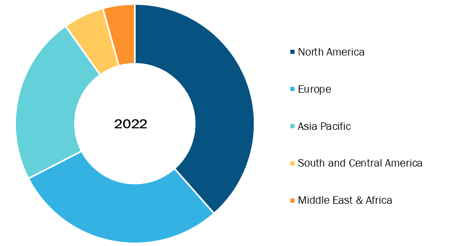Biologically Derived Segment to Dominate Material Type Segment of Tissue Engineering Market
According to our new research study, titled "Tissue Engineering Market Forecast to 2028 – COVID-19 Impact and Global Analysis – by Material Type (Synthetic Material, Biologically Derived Materials, and Others), Application (Orthopedic, Musculoskeletal & Spine, Neurology, Cardiology & Vascular, Skin & Integumentary, Urology, GI & Gynecology, Cancer, and Others), and Geography," the tissue engineering market is projected to grow from US$ 13,236.87 million in 2022 to US$ 29,659.93 million by 2028. It is estimated to rise at a CAGR of 12.2% from 2022 to 2028. The report highlights the key factors driving the market and prominent players' market developments.
An increase in chronic disease incidences, road accidents, trauma injuries, and technological advancements in the field of 3D tissue engineering is driving the growth of the global tissue engineering market. However, the high cost of treatments related to tissue engineering is hindering the market's growth.
The companies engaged in the global Tissue Engineering market witnessed an adverse impact on their services in early 2020 due to the temporary shutdown of various research organizations. Supply chain and manufacturing activities have been disrupted globally due to lockdowns implemented by governments, restricted movement, and other COVID-19 safety precautions. Furthermore, the COVID-19 pandemic was also hindering the conduct of clinical trials, drug development, and the operations of the diagnostic industry worldwide. For instance, Stryker Corporation, a well-known player in the tissue engineering industry, diverted its operations to manufacture COVID-19 diagnostics and PPE kits.
Moreover, according to a survey by Medscape in July 2020, substantial disruption has been witnessed in routine research activities that include tissue engineering and regenerative medicines due to the COVID-19 pandemic. During the initial months of the COVID-19 pandemic, the market was hindered significantly.
The material type segment in the global tissue engineering market is segmented into synthetic material, biologically derived materials, and others. The biologically derived materials segment will hold the largest share of the market in 2022. In contrast, the synthetic material segment is projected to report the highest CAGR of 12.9% in the market during the forecast period.
Natural materials chosen for tissue engineering scaffolds are either compounds of the native extracellular matrix or polymers extracted from other biological systems. Evidence indicates that natural materials can behave similar to the extracellular matrix and possess biocompatibility, biodegradability, and inherent biological functions that could make them suitable for a range of tissue engineering applications. Biologically derived materials are used in creating neo-tissues in vitro that are identical to their fundamental body parts. These materials also help in tissue regeneration by a controlled presentation and on-demand release of specific chemokines at injury sites, tissue-resembling structural, temporary biodegradable support matrices with natural and functional characteristics.
Furthermore, the synthetic materials segment shows the highest CAGR growth due to the biomaterials used to fabricate medicinal products and tissue-engineering scaffolds. Synthetic biomaterials have become essential elements for regenerative medicine and tissue engineering strategies. The growing industrial revolution enables the development of a series of synthetic biomaterials, such as metallics and polymerics, which are well suitable for developmental initiatives. These synthetic materials are biodegradable or non-biodegradable and help restore the structure and function of damaged tissues.
Additionally, synthetic materials are highly beneficial in the biomedical field because of their properties, such as degradation time, porosity, and mechanical characteristics. The advantages of synthetic materials and scaffolds rely on the technical possibility that chemical and physical properties (e.g., porosity, surface characteristics, and degradation products nature) can be optimized for a particular application.
Synthetic materials can be reproduced under controlled conditions and are generally cheaper than biological materials. Moreover, these materials have a long shelf life; thus, they can be produced in large quantities. Some of the most commonly used synthetic materials are polylactic acid (PLA), (polyglycolic acid) PGA, and poly(lactic-co-glycolic) acid (PLGA).
Stryker Corporation, Organogenesis Inc., Cook Biotech Inc., Integra Life Sciences Corporation, 3M, Abbvie., Medtronic, Zimmer Biomet, Baxter International Inc., DePuy Synthes (Johnson & Johnson Services, Inc.), and B. Braun Melsungen AG the key companies operating in the global tissue engineering market.
Global Tissue Engineering Market, by Geography, 2022 (%)

Tissue Engineering Market Overview and Forecast by 2028
Download Free Sample
Tissue Engineering Market Forecast to 2028 - COVID-19 Impact and Global Analysis By Material Type (Synthetic Material, Biologically Derived Materials, and Others) and Application (Orthopedic, Musculoskeletal & Spine, Neurology, Cardiology & Vascular, Skin & Integumentary, Urology, GI & Gynecology, Cancer, and Others)
Tissue Engineering Market Overview and Forecast by 2028
Download Free SampleTissue Engineering Market Forecast to 2028 - COVID-19 Impact and Global Analysis By Material Type (Synthetic Material, Biologically Derived Materials, and Others) and Application (Orthopedic, Musculoskeletal & Spine, Neurology, Cardiology & Vascular, Skin & Integumentary, Urology, GI & Gynecology, Cancer, and Others)
The report segments the global Tissue Engineering market as follows:
The global tissue engineering market is segmented based on material type, application, and geography. Based on material type, the market is segmented into synthetic material, biologically derived materials, and others. Based on application, the market is segmented into orthopedic, musculoskeletal & spine, neurology, cardiology & vascular, skin & integumentary, urology, GI & gynecology, cancer, and others. By geography, the market is segmented into North America (the US, Canada, and Mexico), Europe (the UK, Germany, France, Italy, Spain, and the Rest of Europe), Asia Pacific (China, Japan, India, Australia, South Korea, and the Rest of Asia Pacific), the Middle East & Africa (the UAE, Saudi Arabia, Africa, and the Rest of the Middle East & Africa), and South & Central America (Brazil, Argentina, and the Rest of South & Central America).
Contact Us
Phone: +1-646-491-9876
Email Id: sales@theinsightpartners.com